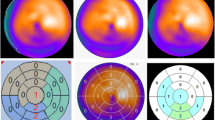Abstract
Due to its noninvasive nature, nuclear imaging has become very important for the diagnosis of human heart diseases. In our research, we are concerned with scintigrams, i. e. images showing the radiation emitted by the blood pool after equal distribution of a radionuclide which has been injected into a peripheral vein of the patient. The two-dimensional intensity distribution on an image corresponds to the three-dimensional radiation distribution of the blood pool. In this way, the interior space of the heart, i.e. the heart cavities are visualized. For assessing the motility of the heart, a sequence of images triggered by ECG is taken, representing one cycle of the heart. Besides diagnosis, periodical supervision after heart surgeries is a major application of the analysis of scintigraphic image sequences.
Access this chapter
Tax calculation will be finalised at checkout
Purchases are for personal use only
Preview
Unable to display preview. Download preview PDF.
Similar content being viewed by others
Literature
Sauer, E. /Sebening, A: Myokard- und Ventrikelszintigraphie, Mannheim, 1980
Geffers, H. et al.: Data Processing and Functional Imaging in Radionuclide Ventriculography, Proc.5th Int. Conf. on Inform. Processing in Medical Imaging, Nashville, 322–331, 1978
Feistel, H. /Sagerer, G.: Ein Beitrag zur orthogonalen Transformation von Gated Blood Studies, Compact News in Nuclear Medicine 6, 266–270, 1981
Tsotsos, J.K. et al.: A Framework for Visual Motion Understanding, IEEE Trans, on PAMI 2, 563–573, 1980
Niemann, H.: Pattern Analysis, Berlin, 1981
Bunke, H. et al.: Smoothing, Thresholding and Contour Extraction in Images from Gated Blood Pool Studies, Proc. 1st ISMIII, Berlin, 146–151, 1982
Findler, N.V. (ed): Associative Networks, New York, 1979
Levesque, H. /Mylopoulus, J.: A Procedural Semantics for Semantic Networks, in/7/
Niemann, H. /Sagerer, G.: A Model as Part of a System for Interpretation of Gated Blood Pool Studies of the Human Heart, Proc. 6th ICPR, Munich, 16–18, 1982
Zadeh, L.A. et al.: Fuzzy Sets and Their Application to Cognitive and Decision Processes, New York, 1975
Nilsson, J.N.: Principles of Artificial Intelligence, Palo Alto, 1980
Kernighan, B.W. /Plaugher, P.J.: Software Tools, Reading, Mass., 1976
Author information
Authors and Affiliations
Editor information
Editors and Affiliations
Rights and permissions
Copyright information
© 1983 Springer-Verlag Berlin Heidelberg
About this chapter
Cite this chapter
Bunke, H., Sagerer, G. (1983). A System for Diagnostic Evaluation of Scintigraphic Image Sequences. In: Neumann, B. (eds) GWAI-83. Informatik-Fachberichte, vol 76. Springer, Berlin, Heidelberg. https://doi.org/10.1007/978-3-642-69391-5_5
Download citation
DOI: https://doi.org/10.1007/978-3-642-69391-5_5
Publisher Name: Springer, Berlin, Heidelberg
Print ISBN: 978-3-540-12871-7
Online ISBN: 978-3-642-69391-5
eBook Packages: Springer Book Archive




